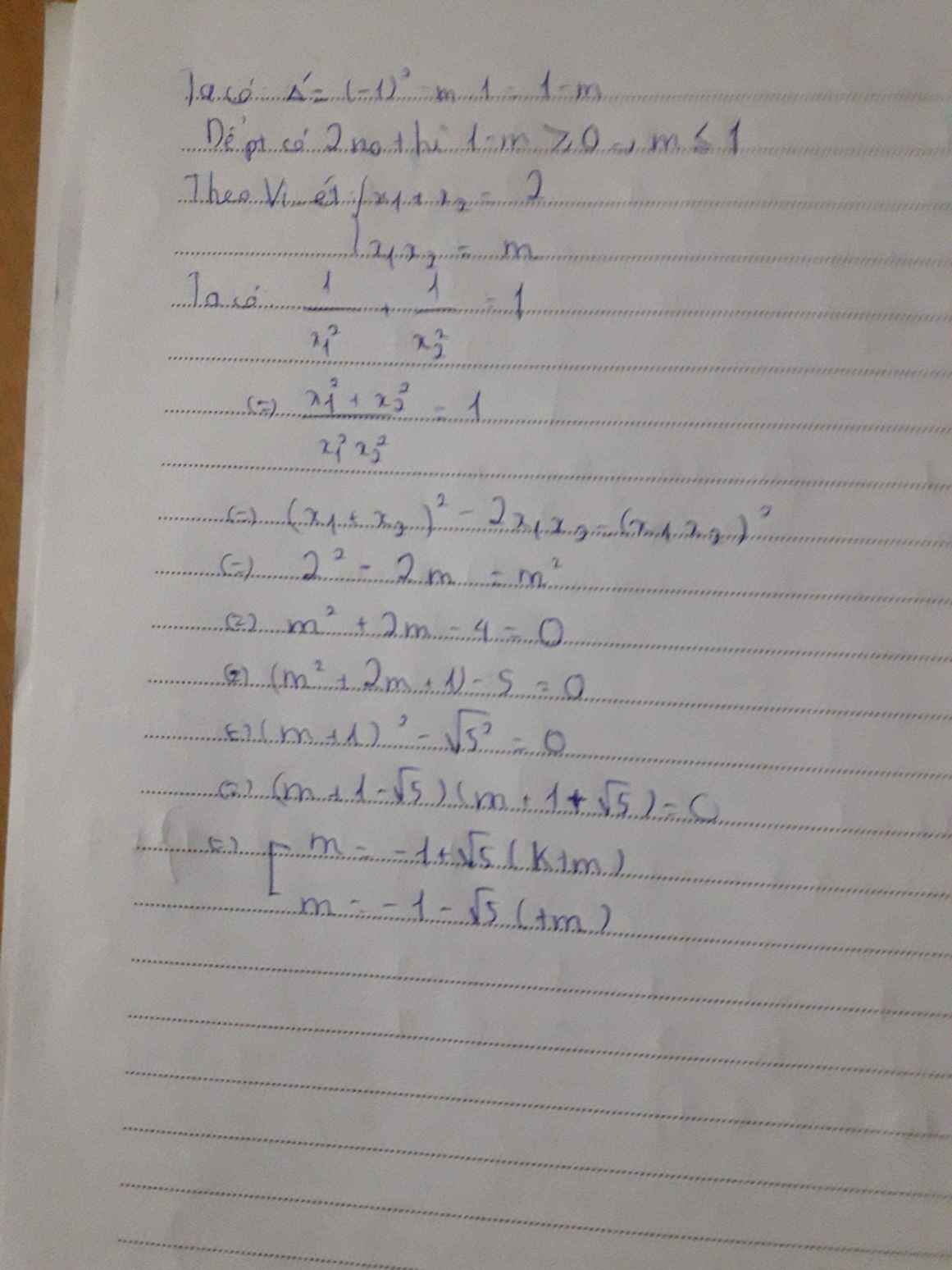Tìm m để pt có 3 nghiệm x1,x2,x3 thỏa: \(x_1^2+x_2^2+x_3^2=5\)
Hãy nhập câu hỏi của bạn vào đây, nếu là tài khoản VIP, bạn sẽ được ưu tiên trả lời.


Bước 1: Tìm điều kiện của tham số để phương trình có hai nghiệm phân biệt.
Bước 2: Khi phương trình đã có hai nghiệm phân biệt, ta áp dụng Vi-ét để tìm các giá trị của tham số.
Bước 3. Đối chiếu với điều kiện và kết luận bài toán.
xem tr sách của anh
Bài 1:
PT có 2 nghiệm \(\Leftrightarrow\Delta=\left(m+2\right)^2-4\cdot2\ge0\Leftrightarrow m^2+4m-8\ge0\Leftrightarrow\left[{}\begin{matrix}m\le-2-2\sqrt{3}\\m\ge-2+2\sqrt{3}\end{matrix}\right.\)
Áp dụng Viét: \(\left\{{}\begin{matrix}x_1+x_2=m+2\\x_1x_2=2\end{matrix}\right.\)
Ta có \(\dfrac{x_1}{x_2}+\dfrac{x_2}{x_1}=\dfrac{9}{2}\Leftrightarrow2\left(x_1^2+x_2^2\right)=9x_1x_2\)
\(\Leftrightarrow2\left[\left(x_1+x_2\right)^2-2x_1x_2\right]=18\\ \Leftrightarrow2\left(m+2\right)^2-8=18\\ \Leftrightarrow2m^2+8m+8-8=18\\ \Leftrightarrow m^2+4m-9=0\\ \Leftrightarrow\left[{}\begin{matrix}m=-2+\sqrt{13}\\m=-2-\sqrt{13}\end{matrix}\right.\left(tm\right)\)

Xét \(\Delta=4\left(m-1\right)^2-4.\left(-3\right)=4\left(m-1\right)^2+12>0\forall m\)
=>Pt luôn có hai nghiệm pb
Theo viet:\(\left\{{}\begin{matrix}x_1+x_2=2\left(m-1\right)\\x_1.x_2=-3\ne0\forall m\end{matrix}\right.\)
Có \(\dfrac{x_1}{x_2^2}+\dfrac{x_2}{x_1^2}=m-1\)
\(\Leftrightarrow x_1^3+x_2^3=\left(m-1\right)x_1^2.x_2^2\)
\(\Leftrightarrow\left(x_1+x_2\right)^3-3x_1x_2\left(x_1+x_2\right)=\left(m-1\right).\left(-3\right)^2\)
\(\Leftrightarrow8\left(m-1\right)^3-3\left(-3\right).2\left(m-1\right)=9\left(m-1\right)\)
\(\Leftrightarrow8\left(m-1\right)^3+9\left(m-1\right)=0\)
\(\Leftrightarrow\left(m-1\right)\left[8\left(m-1\right)^2+9\right]=0\)
\(\Leftrightarrow m=1\)(do \(8\left(m-1\right)^2+9>0\) với mọi m)
Vậy m=1
Vì \(ac< 0\) \(\Rightarrow\) Phương trình luôn có 2 nghiệm phân biệt
Theo Vi-ét, ta có: \(\left\{{}\begin{matrix}x_1+x_2=2m-2\\x_1x_2=-3\end{matrix}\right.\)
Mặt khác: \(\dfrac{x_1}{x_2^2}+\dfrac{x_2}{x_1^2}=m-1\) \(\Rightarrow\dfrac{\left(x_1+x_2\right)\left(x_1^2+x_2^2-x_1x_2\right)}{x_1^2x_2^2}=m-1\)
\(\Leftrightarrow\dfrac{\left(x_1+x_2\right)\left[\left(x_1+x_2\right)^2-3x_1x_2\right]}{x_1^2x_2^2}=m-1\)
\(\Rightarrow\dfrac{\left(2m-2\right)\left(4m^2-8m+13\right)}{9}=m-1\)
\(\Leftrightarrow...\)

Δ=(2m+2)^2-4(-m-5)
=4m^2+8m+4+4m+20
=4m^2+12m+24
=4(m^2+3m+6)
=4(m^2+2*m*3/2+9/4+15/4)
=4(m+3/2)^2+15>=15
=>PT luôn có 2 nghiệm
(x1-x2)^2-x1(x1+3)-x2(x2+3)=-4
=>(x1+x2)^2-4x1x2-(x1+x2)^2+2x1x2-3(x1+x2)=-4
=>-2(-m-5)-3(2m+2)=-4
=>2m+10-6m-6=-4
=>-4m+4=-4
=>-4m=-8
=>m=2

Phương trình có nghiệm \(\Leftrightarrow\Delta'\ge0\Leftrightarrow1-m\ge0\Leftrightarrow m\le1\)
Theo hệ thức Vi-ét: \(\left\{{}\begin{matrix}x_1+x_2=2\\x_1x_2=m\end{matrix}\right.\) (1)
Ta có: \(\dfrac{1}{x^2}+\dfrac{1}{x^2}=1\Leftrightarrow\dfrac{x^2_1+x^2_2}{x^2_1x^2_2}=1\Leftrightarrow\dfrac{\left(x_1+x_2\right)^2-2x_1x_2}{\left(x_1x_2\right)^2}=1\) (2)
Từ (1) và (2) \(\Rightarrow4-2m=m^2\Leftrightarrow m^2+2m-4=0\)
\(\Delta'=1+4=5\Rightarrow\sqrt{\Delta'}=\sqrt{5}\Rightarrow\left[{}\begin{matrix}m=-1+\sqrt{5}\left(\text{loại}\right)\\m=-1-\sqrt{5}\left(\text{nhận}\right)\end{matrix}\right.\)
Vậy \(m=-1-\sqrt{5}\)

Có\(\Delta=4\left(m+1\right)^2-4\left(2m-3\right)=4m^2+16>0\forall m\)
=> pt luôn có hai nghiệm pb
Theo viet có: \(\left\{{}\begin{matrix}x_1+x_2=2\left(m+1\right)\\x_1x_2=2m-3\end{matrix}\right.\)
Có :\(P^2=\left(\dfrac{x_1+x_2}{x_1-x_2}\right)^2=\dfrac{4\left(m+1\right)^2}{\left(x_1+x_2\right)^2-4x_1x_2}\)
\(=\dfrac{4\left(m+1\right)^2}{4\left(m+1\right)^2-4\left(2m-3\right)}=\dfrac{4\left(m+1\right)^2}{4m^2+16}\)\(\ge0\)
\(\Rightarrow P\ge0\)
Dấu = xảy ra khi m=-1

Tìm m
ở trog bảng chữ cái đó bạn.